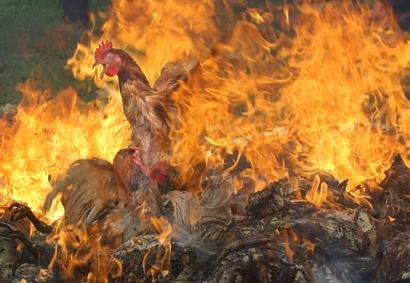
In much the same way as the War Nerd gets a boner from cataloging exotic and bloody conflicts, I get my stiffies from closely following the progress of the world’s most cunning and devious infectious diseases.
I dunno — maybe it’s the result of a troubled and anti-social adolescence combined with a biology degree, but there’s something about a deadly new pathogen laying waste to wide swaths of blissfully unsuspecting populace that really pops my tent pole. Our monumental human hubris suddenly crumbles, outwitted by a tiny package of genetic material and proteins, one billionth our size, that’s been finely honed by evolution to hijack the machinery of our cells, often killing us in gruesome and spectacular ways as an unexpected side benefit.
So when H5N1 — otherwise known as bird flu (or, depending on where you get your TV news from, also: “deadly bird flu,” “the deadly H5N1 avian influenza virus,” or my redundant favorite, “the deadly H5N1 avian bird flu”) — appeared on the scene in south-east Asia in late 2003, I grabbed my bucket of popcorn and got ready to watch the horror show.
But when the virus made its way to Russia late last year, I ditched my snacks and grabbed some Tamiflu and a gas mask instead. That’s because the Russian government is telling some awfully queer stories about how they’re dealing with the disease, and none of what they’re saying is making me feel particularly safe.
As you probably know by now from watching CNN, H5N1 is a disease that really only affects birds. So why should we care? First of all, H5N1 is a remarkably effective killing machine. It’s already done the business with more than a hundred million birds worldwide in a matter of a few months. And now, it’s made its way from wild, migratory birds to domestic poultry — including several hotspots in the backwoods of the Ural Mountains. And those are just the ones the Russian government is telling us about.
The second reason is that H5N1 — like all influenza viruses — is incredibly adept at fine-tuning its genetic makeup. This allows it to really pad out its resume with new species it can happily infect.
Last week, a paper in the American journal Science outlined the exact structure of the hemagglutinin protein — the “H” in H5N1. It’s a tiny, mushroom-shaped projectile that sticks out from the surface of the virus, allowing it to latch onto the cells that line the airway, which is the first step of an infection.
Now, the cells that line the respiratory tracts of birds and humans are slightly different. In birds, these cells produce a certain kind of sugar molecule. It turns out that the H protein in H5N1 happily gobbles these sugars for breakfast, meaning that birds get penetrated by the virus faster than fresh pole-dancer at Safari Gentlemen’s Club.
We humans, on the other hand, are lucky fuckers indeed, because our respiratory cells are coated with a different kind of sugar. So, by and large, H5N1 slides harmlessly down our throats like… I’d rather not say.
But don’t get too relaxed yet, sports-fans. Because it also turns out that the difference between those two types of sugars is very small indeed. In fact, if the H5N1 virus can manage to sustain only two tiny mutations, it’ll make short work of our respiratory cells as well.
So, all that lies between us and a nightmare world of phlegm-clogged corpses decaying on the floors of overcrowded hospitals is two tiny genetic hiccups in a virus that’s already so prone to violent fluctuations in its genome that it makes HIV look like a quiet day at the beach.
Those in the know about flu say the only way to prevent the next human flu pandemic is to a) kill birds at risk of catching H5N1; b) establish a very rigid surveillance program in regions where poultry and humans intermix, and c) vaccinate domestic birds against the virus.
In Russia, some success has already been achieved with culling birds at risk of catching the disease and setting up quarantine zones.
But that’s not enough. The government has to ensure that, in the tiny villages in the southern part of the Urals district where the bulk of reported H5N1 cases have occurred, the emergence of new infections is closely monitored.
But how many thousands of rural villagers who live on $50 a month, who keep a few dozen chickens in a shed at the back of the house for meat and eggs, are going to fess up to owning them when the officials pop by to collect them for slaughter? And who’s keeping an eye on these officials, a thousand miles from Moscow, to ensure they’re not taking a hundred rubles from a babushka to ignore her modest collection of hens, which she needs to feed her granddaughter?
Still, the smart money is best spent on surveillance — to ensure humans and infected birds are kept well apart.
But in February, Gennady Onischenko, Russia’s chief doctor, appeared on state television, saying millions of dollars will be allocated to churning out hundreds of millions of doses of H5N1 vaccine — and that each and every domestic fowl in 11 time zones worth of land will be vaccinated, beginning in spring. No word on how many monkeys flew out of his ass after saying that, or whether those monkeys were vaccinated too.
Indeed, a month later, right on cue, state television showed truckload after truckload of shiny new vaccine dispatched to parts unknown, from a Soviet-era lab in the Vladimir region that had been magically activated and brought up to full production capacity in the space of a few weeks.
Never mind that the process of manufacturing vaccines is still based on 1950s technology and is incredibly resource-and time-intensive.
According to Michael Osterholm, the director of the Centre for Infectious Disease Research and Policy in the U.S.: “The current system of producing and distributing influenza vaccine is broken, both technically and financially.” In other words: if the United States doesn’t have a hope in hell of vaccinating all of its birds, how is Russia going to manage to do it in a matter of months, as promised? Right now we don’t know — since the labs are military, no one in the media’s allowed to take a serious look.
It’s admirable that the Russian government has made avian influenza a priority. But if their promises of action are just another smokescreen, it’s the health of the planet that’s at stake.
This article was published in issue #234 of The eXile, March 2006.
Read more: bird flu, exile issue 234, Benjamin Velizar, eXile Classic


Got something to say to us? Then send us a letter.
Want us to stick around? Donate to The eXiled.
Twitter twerps can follow us at twitter.com/exiledonline















Leave a Comment
(Open to all. Comments can and will be censored at whim and without warning.)
Subscribe to the comments via RSS Feed